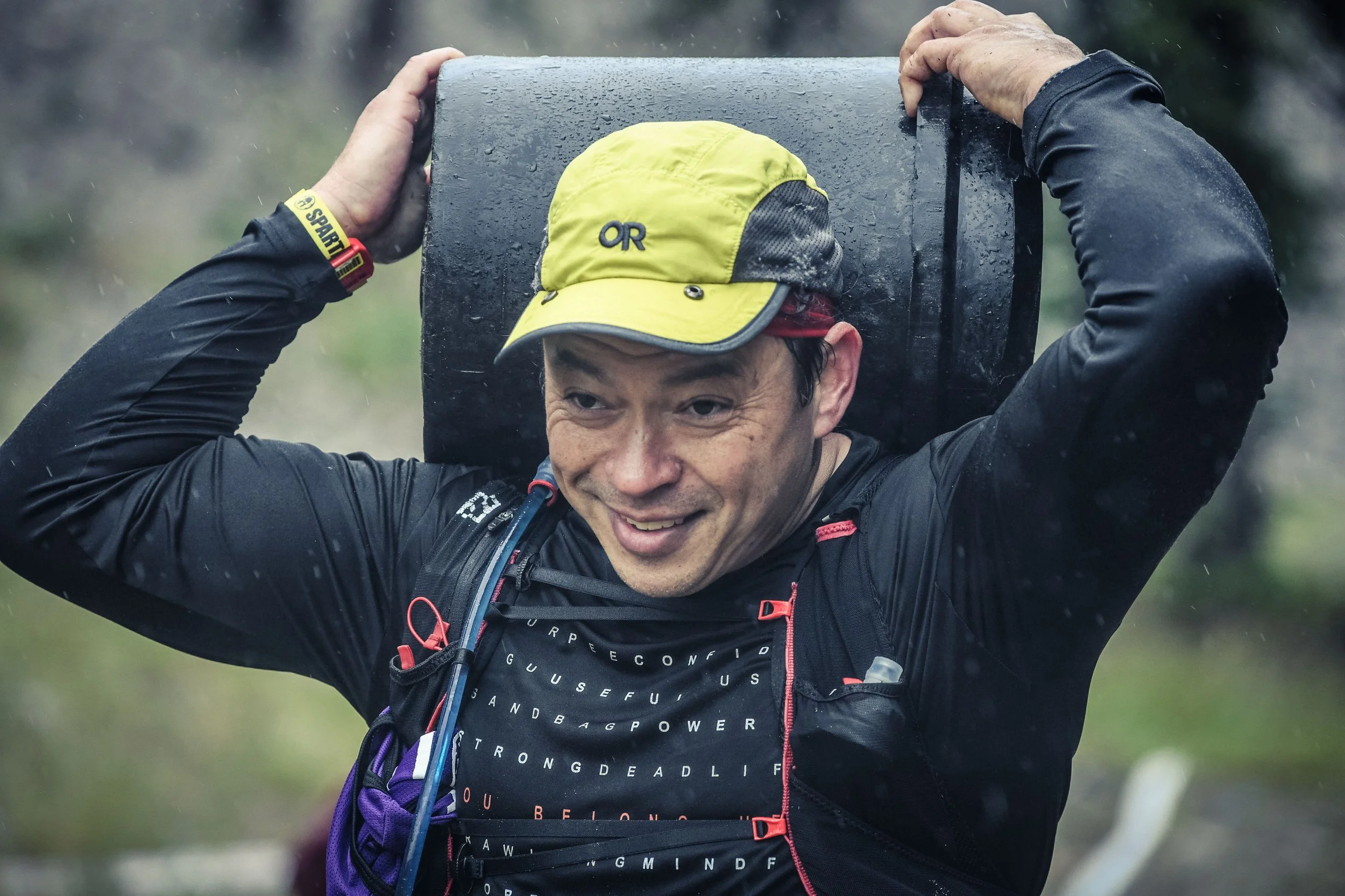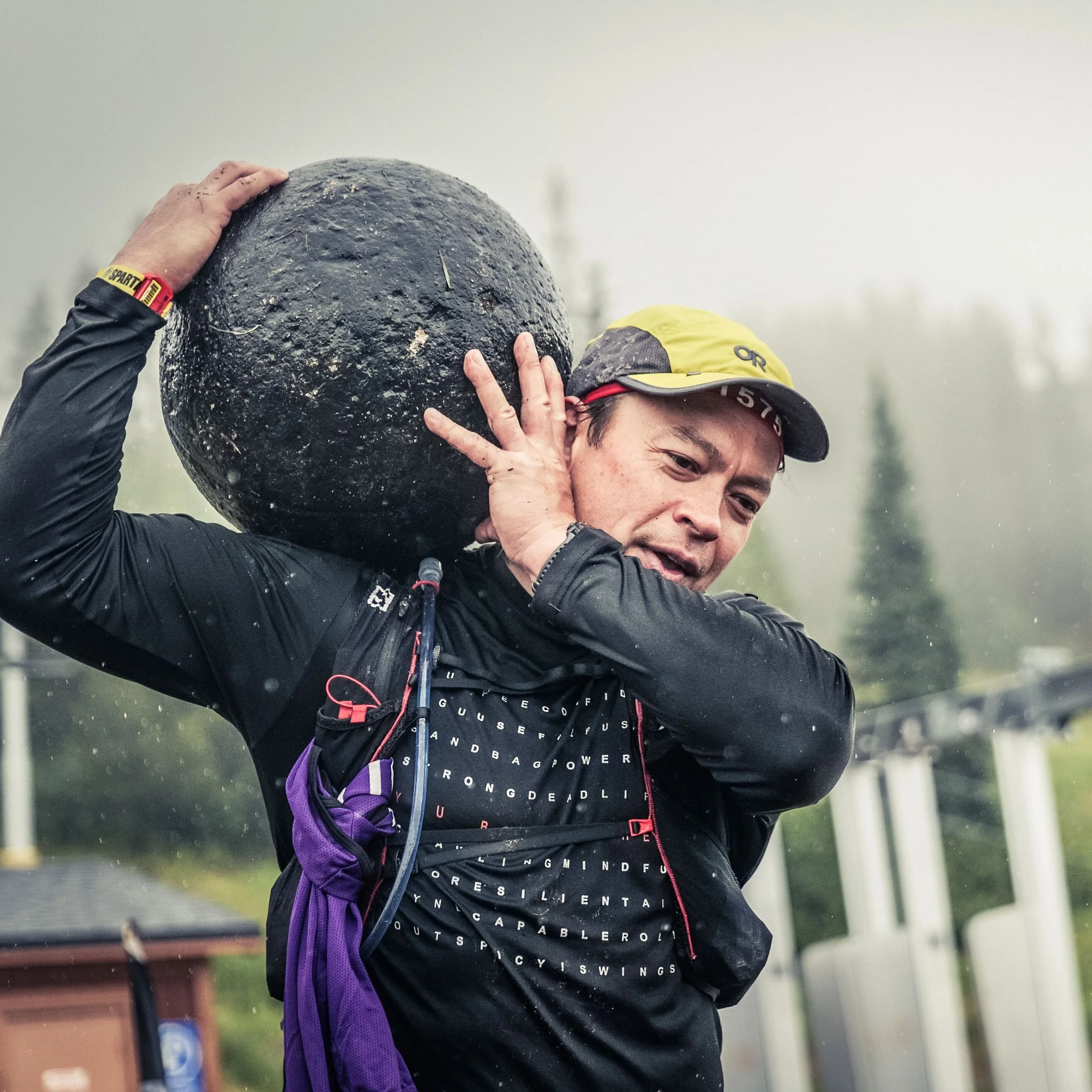Unconventional Strength Training: Building Real-World Power with Odd Objects and Complex Movements
When “Strong” Meets Reality
My first real taste of unconventional strength came at the 2015 Spartan Race Beast in Sun Peaks. I had been lifting for years, logging heavy barbell squats and trap-bar deadlifts, and I thought I was well prepared. Then came the sandbag carry, the bucket carry, the log carry, the Atlas stone, the tractor-tire flip, and the tractor-pull (dragging a cinder block on a chain grinding through dirt and gravel halfway up a mountain). By the halfway mark my forearms were fried, my lungs were burning, and the neat, symmetrical strength I had built in the gym suddenly felt insufficient.
That race humbled me in the best possible way. It reminded me that the world rarely presents us with perfectly balanced barbells or ideal leverage. The things that truly test our capability tend to be awkward, heavy, and unpredictable. They force us to figure it out, to stabilise, adjust, and move through discomfort with focus and control.
That experience became the foundation for how I look at strength today. Odd objects and complex movements look rough around the edges, but they build the kind of capability you can actually rely on when life gets messy.
Why Unconventional Strength Matters
There’s an old French motto coined by physical-culture pioneer Georges Hébert: “Être fort pour être utile.” Translated, it means “Be strong to be useful.” It’s simple, but it says everything I believe about training. Strength for its own sake can be impressive, but strength that translates to real tasks, real challenges, and real life is invaluable.
Unconventional strength work teaches your body to produce and control force under less-than-ideal circumstances: a sandbag that slumps to one side, a medicine ball that rolls away if you lose focus, a sled that sticks to the turf until you dig in harder. The benefit isn’t just muscle; it’s adaptability. You learn to stabilise from your centre, to breathe under strain, and to stay present when the load shifts mid-lift.
And yes, you can still train for aesthetics. Chasing capability doesn’t mean abandoning appearance. In fact, many of my clients find that once they start moving heavy, awkward things, their physiques improve because they’re recruiting more muscle and burning more energy in every plane of movement. It’s not aesthetics or real-world capability, it’s both.
The Limits of Conventional Strength
Most people train in straight lines. Machines lock you into fixed paths, guiding your movement so you can’t deviate. Barbells and dumbbells free things up slightly, but they’re still balanced tools designed for symmetry and predictability. That’s fine for building foundational strength, but it doesn’t prepare you for the chaos of reality.
Think of it as a spectrum of progression:
Machines → Free Weights → Odd Objects → Natural Environments
Machines teach muscle control.
Free weights teach coordination.
Odd objects teach problem-solving.
Natural environments (hills, sand, mud, uneven ground) teach resilience.
When you pick up something that doesn’t want to be lifted, you have to engage everything: hands, arms, shoulders, core, hips, even your breathing pattern. Every rep becomes a micro-lesson in stability and focus. That’s the difference between strength you measure in kilograms and strength you feel when life throws a curveball.
What Unconventional Training Demands
Odd-object training changes the rules. A 40- to 60-pound sandbag can humble someone who squats twice their bodyweight because it shifts, compresses, and refuses to cooperate. The moment you get lazy, it moves. The result is a full-body conversation between you and gravity.
Here’s what it demands:
1. Grip and stability
Nothing exposes weak hands like a wet, lumpy sandbag or a slick plate hold. You learn to squeeze, hook, and adjust... skills that carry into climbing, yard work, and every other form of manual labour life throws at you.
2. Core integration
When the weight moves off-centre, your core fires to stabilise. You stop thinking of “abs” as a show muscle and start feeling them as a transmission that links upper and lower body power.
3. Awareness and focus
You can’t zone out. If your mind drifts, the bag slides or the ball rolls. Every lift demands attention to breath, alignment, and timing.
4. Respect for awkwardness
Some loads simply don’t feel right, and that’s the point. You learn to find stability inside instability, stacking joints, shifting stance, and adjusting leverage until the movement flows. That process translates far beyond the gym.
It’s not chaos for chaos’s sake. It’s controlled exposure to imperfection, and that’s what develops both resilience and skill.
Real-World Capability: Strong to Be Useful
This is where unconventional training shines. It builds the kind of practical strength you notice outside the gym: lifting kids without tweaking your back, hauling garden soil, wrestling a snowblower through slush, loading a kayak onto a roof rack. Those are the moments when grip, core tension, and balanced effort matter far more than your one-rep max.
It also bridges beautifully into athletic movement. Trail running, obstacle racing, hiking steep terrain... all of them demand the same mix of stability, awareness, and adaptability you build with odd objects. Every time you clean a shifting sandbag or carry it across the room, you’re rehearsing for the unpredictable.
If you read my “Backyard Project” article, you’ll remember the months I spent tearing out our old deck and replacing it with a stone patio and retaining wall. That job became a masterclass in unconventional strength: thousands of pounds of gravel and concrete blocks, endless wheelbarrow trips, constant lifting and repositioning. It wasn’t glamorous, but it was the purest form of functional fitness I’ve ever done. Every wheelbarrow load was a farmer carry. Every lifted block a partial deadlift with rotation. The project reinforced everything I try to teach here: real strength isn’t confined to four gym walls.
So yes, the gym builds strength, but the world tests it. When you can lift, drag, carry, and stabilise odd objects, you’re ready for that test.
Character Built Under Load
There’s another layer to this work that has nothing to do with muscle fibres. It’s about who you become in the process.
Odd-object training cultivates humility. Watch someone who can deadlift twice their bodyweight struggle with a 40- to 60-pound sandbag and you’ll see the point immediately. It reminds you that strength is contextual and that numbers don’t always tell the whole story.
It builds patience and problem-solving. You can’t force an awkward load into submission; you have to figure it out. Find your balance, breathe, adjust your grip, move again. That cycle of attempt, adapt, and succeed is the same one that drives progress in every other part of life.
And it builds presence. You can’t text between sets when you’re shouldering a sloshing bag of sand. You’re too busy staying upright. The work demands full attention, which makes it oddly meditative. For a few minutes, all the noise drops away. It’s just you, the object, and gravity.
There’s also a quiet kind of honesty that comes with this work. You can’t fake it. You can’t pose your way through a heavy carry or mask poor mechanics with momentum. The load tells the truth. When it pulls you off balance or refuses to move until your positioning improves, that’s feedback, not failure. Learning to listen to that feedback without ego is a skill that spills over into every corner of life.
It teaches emotional control. Anyone who has ever fought through a difficult set knows that internal voice — the one that says “quit” when it gets uncomfortable. Odd-object training turns that whisper into a conversation. You learn to breathe through it, to stabilise, to make small adjustments rather than panicking. That’s emotional regulation in physical form, and it shows up everywhere else once you’ve practised it enough.
In the end, these sessions do more than build strength. They build composure. You learn to stay calm when things feel unstable, to find your footing, and to keep moving. That’s the kind of strength that lasts.
That kind of focus bleeds into other areas like work, relationships, and decision-making. When you train yourself to stay calm under physical load, you start handling mental load the same way.
How to Start (and Do It Safely)
If you’ve never lifted anything that wasn’t shaped for your convenience, start simple. Find, buy or make yourself a sandbag, or grab a medicine ball. You don’t need a strongman set-up in your garage; you just need something heavy enough to demand respect.
Three movements cover nearly everything you need at the beginning:
1. Shouldering
Lift the bag or ball from the ground to one shoulder, reset, and repeat on the other. It can feel awkward or messy, but that’s the point. You’ll feel your hips, back, and core coordinating in real time. Sets of 10 reps per side can be a real eye-opener.
2. Ground-to-Overhead
Hoist the load to chest height, then press or drive it overhead. Keep the movement smooth and controlled, focusing on bracing through your mid-section rather than muscling it up.
3. Loaded Carries
Pick the object up and walk. Bear-hug it, hold it at your side, carry it on your shoulder or overhead. Distance is often more revealing than load; a moderate weight carried for 30–60 seconds can light up your entire body.
Once those feel comfortable, add variety: windmills for rotational stability, get-ups for coordination, overhead holds or walks for shoulder endurance, even throw-and-chase drills if you’ve got outdoor space. Sled drags or pushes are brilliant if you have room and a suitable surface, but they’re not essential.
The coaching cues I give every client starting this work are simple:
Control The Load and Control The Speed. Find your balance before moving faster.
Stack / Align Your Joints where and when you can. Good mechanics make a big difference to how much effort you need to expend.
Shaky Is OK. In fact, it’s totally normal when the movement is new and when fatigue starts to creep in.Expect to feel unsteady at first and don’t fight it. That instability is the teacher. As long as you still feel like you’re safe (or at least not unsafe or scared... LOL), keep going.
A good rule of thumb: you should look like you’re working hard, but not like you’re in danger of losing the object or yourself.
The Mindset That Makes It Work
This kind of training isn’t about chaos; it’s about control under imperfect conditions. The goal isn’t to look reckless but to practise composure when things aren’t perfectly aligned. Every rep teaches you to find the stable line through instability.
It’s a mindset that transfers beautifully beyond training. Life rarely hands you perfect conditions. Projects change scope, kids get sick, weather ruins plans, motivation disappears. The people who keep progressing aren’t the ones who wait for ideal circumstances; they’re the ones who adapt without losing alignment.
Unconventional strength work gives you that skill in micro form. You lift something awkward, it shifts, you adjust, you keep moving. Over time that becomes your default pattern of response: adapt, align, continue. That’s resilience in motion.
And circling back to Hébert, this is what it means to be strong to be useful. Not just strong when everything is perfect, but strong enough to stay functional, capable, and calm when it isn’t.
Closing Reflection: The Kind of Strength You Can Count On
Every now and then I’ll see a client pick up a sandbag for the first time, expecting an easy win. A few seconds later they’re wide-eyed, breathing hard, wondering how something so small could feel so heavy. And then something clicks. The movement cleans up. They shift from frustration to determination, from brute force to smart force. That’s the moment I love most, the instant they stop fighting the object and start working with it.
That same shift happens in life all the time. The load changes shape, and we either resist it or adapt. Strength training just gives us a safe, repeatable way to practise that adaptation until it becomes part of who we are.
Once you’ve built that kind of real-world capability, use it. BE USEFUL. Employ that capability in your own life, and even better, use it to help others whenever an opportunity arises.
If you’re here in the Abbotsford area and curious to experience it first-hand, reach out through our Contact Us page. Come train with me, learn the technique, and discover just how capable your body can become when you step outside the familiar.
Because strength worth having isn’t built in perfect conditions. It’s built in the messy middle, where you learn, adjust, and keep moving forward anyway.
Never Miss a Post
Never miss a post with our (almost) weekly email newsletter. Get our best training notes, simple weekly plans, and new articles, plus practical nutrition guidance, cooking tips, and reader-friendly recipes. One email a week, no noise, unsubscribe anytime.
👉 www.btgfitness.com/email-signup



